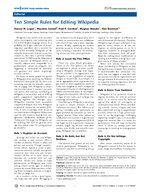User:MirriamRachele
I am a La Trobe University student, studying at La Trobe University assigned to edit and update specific oral health pages. This is a sample of how to reference = [1]

This is the workshop that supports the Evidence Based Oral Health Practice (ORH3EBP) Group Assignment in the Oral Health program at La Trobe University.
The assignment requires you to:
- Create a Wiki account for yourself – choose a user name that is not your real name and ensure this is given to me
- Access the nominated Wikipedia page on a regular basis throughout the study period
- Decide on the important areas of information that are needed – what information do people need? This could form the basis of ‘sections’ on the page.
- Edit the information on the page to ensure it is evidence based – academic references must be provided to support the information you are using. (1000 words required)
- Engage in the ‘talk’ linked to the Wikipage.
Please find help resources below.
Wikipedia articles and projects
[edit]List the articles you're interested in editing, and projects you might collaborate in.
Useful images
[edit]Go to Wikimedia Commons and embed useful or interesting images here, as a "gallery".
Help resources
[edit]La Trobe University Oral Health Wikipedia project
[edit]
Participants
[edit]- Jackjaq (talk) 02:31, 4 December 2018 (UTC)
- Zam.Zamani (talk) 02:32, 4 December 2018 (UTC)
- A18927192 (talk) 02:32, 4 December 2018 (UTC)
- Krista tayag (talk) 02:33, 4 December 2018 (UTC)
- Kathryn Burton (talk) 02:34, 4 December 2018 (UTC)
- Jemmalang (talk) 02:38, 4 December 2018 (UTC)
- AngeW2018 (talk) 02:35, 4 December 2018 (UTC)
- MirriamRachele (talk) 02:39, 4 December 2018 (UTC)
- EmilyShaw1 (talk) 02:39, 4 December 2018 (UTC)
- Suzanne maree Lovell (talk) 02:40, 4 December 2018 (UTC)
- Sanjay 19341519 (talk) 02:41, 4 December 2018 (UTC)
- Juliamcnae (talk) 02:42, 4 December 2018 (UTC)
- Irenehpark (talk) 02:43, 4 December 2018 (UTC)
- Anitapxx (talk) 02:43, 4 December 2018 (UTC)
- JTawadros (talk) 02:45, 4 December 2018 (UTC)
- BOHStudentLatrobe (talk) 02:45, 4 December 2018 (UTC)
- Anikaniehaus (talk) 02:47, 4 December 2018 (UTC)
- Tahlial (talk) 02:48, 4 December 2018 (UTC)
- Sakila121 (talk) 02:50, 4 December 2018 (UTC)
- StephanieS95 (talk) 02:51, 4 December 2018 (UTC)
- Christinenacief (talk) 02:52, 4 December 2018 (UTC)
- Salha.m (talk) 02:53, 4 December 2018 (UTC)
- Cmoushi (talk) 02:54, 4 December 2018 (UTC)
- MontanaCarracher (talk) 02:54, 4 December 2018 (UTC)
- Catia Righele (talk) 02:55, 4 December 2018 (UTC)
- LarissaJH (talk) 02:55, 4 December 2018 (UTC)
- HannahB18968179 (talk) 02:56, 4 December 2018 (UTC)
TEST
[edit]This is a test before updating a controversial topic on a public page to add more relevant and academic information as part of a university assessment. This information does not represent my opinions, interests or views.
Safe sex
[edit]Rubber dams (also know as a dental dam) are a seldom used adjunctive barrier which are sometimes used for protecting against the contraction and spread of sexually transmitted infections (STIs) such as human immunodeficiency virus (HIV), herpes simplex virus type 1 (HSV-1), hepatitis, bacterial infections (such as candidiasis or bacterial vaginosis) and other STIs by acting as a physical barrier against the exchange of bodily fluids during oral sex. [2][3][4]
History of use:
They were initially promoted in the 1980s in some safer sex campaigns as a barrier to prevent transmission of STIs during oral sex. [5] They were introduced for use in some women's prisons in Canada and Australia (in NSW, ACT, WA and SA states) in the 1990s as a form of sexual barrier protection after the World Health Organisation recommended that female prisoners should have access to dental dams, however they are not widely utilised and there is only anecdotal evidence to suggest that dental dams may be beneficial in protecting against STIs when used in woman-to-woman oral sex. [6][7][8][9][10][11] Inmates have reported numerous barriers for dental dam use including the dam being too thick, lack of availability, poor taste and reduced sensations when used for oral sex. Dental dams are often reappropriated for other uses by prison inmates, such as hair elastics, placemats or shoelaces. [12] They are relatively expensive and difficult to obtain outside of the prison system. [13] Rubber dams are not manufactured, marketed, registered, tested or evaluated for their effectiveness as an STI prevention aid, and no studies currently exist on their permeability to STI pathogens. [14]
Application:
After lubrication with a water-based lubricant, an unpunctured dental dam may be held over the vulva or anus, allowing oral stimulation of these areas without transmission of bodily fluids or direct physical contact. Plastic cling wrap, condoms or latex gloves (cut open longitudinally) can be used for STI protection in a similar manner as a dental dam, by providing a physical barrier to cover the vaginal or anal areas during oral sex, these alternative barrier methods are more affordable and readily available than dental dams. [15][16][17]
SafeSex - Edit 2
[edit]Dental dams are sometimes recommended for use during oral sex to protect against sexually transmitted infections (STIs). Dental dams are most frequently marketed towards women who have sex with women to use as a physical barrier against the exchange of bodily fluids during cunnilingus and anilingus. However, they are rarely used for this purpose,[18][19][9] and there is no good evidence to show that their use reduces the risk of STI transmission, including the risk of infection with human immunodeficiency virus, herpes simplex virus type 1, hepatitis or bacterial infections.[9][20]
After lubrication with a water-based lubricant, an unpunctured dental dam may be held over the vulva or anus, allowing oral stimulation of these areas without transmission of bodily fluids or direct physical contact. Plastic cling wrap, condoms or latex gloves (cut open longitudinally) can be used for STI protection in a similar manner as a dental dam, by providing a physical barrier to cover the vaginal or anal areas during oral sex, these alternative barrier methods are more affordable and readily available than dental dams.[18][21][22]
Dental dams were initially promoted in the 1980s in some safer sex campaigns as a barrier to prevent transmission of STIs during oral sex.[18] They were introduced for use in some women's prisons in Canada and Australia (in NSW, ACT, WA and SA states) in the 1990s as a form of sexual barrier protection after the World Health Organization (WHO) recommended that female prisoners should have access to dental dams.[18][23] Inmates have reported numerous barriers for dental dam use, including the dam being too thick, lack of availability, poor taste, and reduced sensations when used for oral sex. Dental dams are often reappropriated for other uses by prison inmates, such as hair elastics, placemats or shoelaces.[24] They are relatively expensive and difficult to obtain outside of the prison system.[25] Rubber dams are not manufactured, marketed, registered, tested or evaluated for their effectiveness as an STI prevention aid, and no studies currently exist on their permeability to STI pathogens.[26]
References
[edit]- ^ C J La Trobe Society, 'Early Life', The C J La Trobe Society [website], accessed 7 Jan. 2015.
- ^ Stevens, P; Hall, J (July 2001). "Do women use dental dams? Safer sex practices of lesbians and other women who have sex with women". Journal of Obstetric, Gynecologic & Neonatal Nursing. 30 (4): 439–447. doi:10.1111/j.1552-6909.2001.tb01563.x.
- ^ Marrazzo, J; Coffey, P; Bingham, A (March 2005). "Sexual Practices, Risk Perception and Knowledge Of Sexually Transmitted Disease Risk Among Lesbian and Bisexual Women". Perspectives on Sexual and Reproductive Health. 37 (1): 6–12. doi:10.1111/j.1552-6909.2001.tb01563.x.
- ^ Richters, J; Clayton, S (June 2010). "The practical and symbolic purpose of dental dams in lesbian safer sex promotion". Sexual Health. 7 (2): 103–106. doi:10.1071/SH09073.
- ^ Richters, J; Prestage, G; Schneider, K; Clayton, S (June 2010). "Do women use dental dams? Safer sex practices of lesbians and other women who have sex with women". Sexual Health. 7 (2): 165–9. doi:10.1071/SH09072. PMID 20465981.
- ^ Richters, J; Prestage, G; Schneider, K; Clayton, S (June 2010). "Do women use dental dams? Safer sex practices of lesbians and other women who have sex with women". Sexual Health. 7 (2): 165–9. doi:10.1071/SH09072. PMID 20465981.
- ^ "Dental Dams | Sexually Transmitted Infections | Adults | sexualityandu.ca - Your Link to Sexual Well-Being". sexualityandu.ca. 2006-12-15. Retrieved 2010-09-12.
- ^ Yap, L; Richters, J; Butler, T; Schneider, K; Kirkwood, K; Donovan, B (June 2010). "Sexual practices and dental dam use among women prisoners - a mixed methods study". Sexual Health. 7 (2): 170–6. doi:10.1071/SH09138. PMID 20465982.
- ^ a b c Jonathan Zenilman, Mohsen Shahmanesh (2012). Sexually transmitted infections : diagnosis, management, and treatment. Sudbury, Mass.: Jones & Bartlett Learning. p. 330. ISBN 9780763786755.
- ^ "Effectiveness of interventions to address HIV in prisons" (PDF). www.who.int/. Centers for Disease Control and Prevention. Retrieved 2019-03-25.
- ^ Richters, J; Clayton, S (June 2010). "The practical and symbolic purpose of dental dams in lesbian safer sex promotion". Sexual Health. 7 (2): 103–106. doi:10.1071/SH09073.
- ^ Yap, L; Richters, J; Butler, T; Schneider, K; Kirkwood, K; Donovan, B (June 2010). "Sexual practices and dental dam use among women prisoners - a mixed methods study". Sexual Health. 7 (2): 170–6. doi:10.1071/SH09138. PMID 20465982.
- ^ Stevens, P; Hall, J (July 2001). "Do women use dental dams? Safer sex practices of lesbians and other women who have sex with women". Journal of Obstetric, Gynecologic & Neonatal Nursing. 30 (4): 439–447. doi:10.1111/j.1552-6909.2001.tb01563.x.
- ^ Richters, J; Clayton, S (June 2010). "The practical and symbolic purpose of dental dams in lesbian safer sex promotion". Sexual Health. 7 (2): 103–106. doi:10.1071/SH09073.
- ^ Yap, L; Richters, J; Butler, T; Schneider, K; Kirkwood, K; Donovan, B (June 2010). "Sexual practices and dental dam use among women prisoners - a mixed methods study". Sexual Health. 7 (2): 170–6. doi:10.1071/SH09138. PMID 20465982.
- ^ Stevens, P; Hall, J (July 2001). "Do women use dental dams? Safer sex practices of lesbians and other women who have sex with women". Journal of Obstetric, Gynecologic & Neonatal Nursing. 30 (4): 439–447. doi:10.1111/j.1552-6909.2001.tb01563.x.
- ^ "Dental Dam Use". www.cdc.gov. Centers for Disease Control and Prevention. Retrieved 2018-09-18.
- ^ a b c d Richters, J; Prestage, G; Schneider, K; Clayton, S (Jun 2010). "Do women use dental dams? Safer sex practices of lesbians and other women who have sex with women". Sexual Health. 7 (2): 165–9. doi:10.1071/SH09072. PMID 20465981.
- ^ Yap, L; Richters, J; Butler, T; Schneider, K; Kirkwood, K; Donovan, B (Jun 2010). "Sexual practices and dental dam use among women prisoners--a mixed methods study". Sexual Health. 7 (2): 170–6. doi:10.1071/SH09138. PMID 20465982.
- ^ Marrazzo, J; Coffey, P; Bingham, A (March 2005). "Sexual Practices, Risk Perception and Knowledge Of Sexually Transmitted Disease Risk Among Lesbian and Bisexual Women". Perspectives on Sexual and Reproductive Health. 37 (1): 6–12. doi:10.1111/j.1552-6909.2001.tb01563.x.
- ^ Yap, L; Richters, J; Butler, T; Schneider, K; Kirkwood, K; Donovan, B (June 2010). "Sexual practices and dental dam use among women prisoners - a mixed methods study". Sexual Health. 7 (2): 170–6. doi:10.1071/SH09138. PMID 20465982.
- ^ "Dental Dam Use". www.cdc.gov. Centers for Disease Control and Prevention. Retrieved 2018-09-18.
- ^ Yap, L; Richters, J; Butler, T; Schneider, K; Kirkwood, K; Donovan, B (June 2010). "Sexual practices and dental dam use among women prisoners - a mixed methods study". Sexual Health. 7 (2): 170–6. doi:10.1071/SH09138. PMID 20465982.
- ^ Yap, L; Richters, J; Butler, T; Schneider, K; Kirkwood, K; Donovan, B (June 2010). "Sexual practices and dental dam use among women prisoners - a mixed methods study". Sexual Health. 7 (2): 170–6. doi:10.1071/SH09138. PMID 20465982.
- ^ Stevens, P; Hall, J (July 2001). "Do women use dental dams? Safer sex practices of lesbians and other women who have sex with women". Journal of Obstetric, Gynecologic & Neonatal Nursing. 30 (4): 439–447. doi:10.1111/j.1552-6909.2001.tb01563.x.
- ^ Richters, J; Clayton, S (June 2010). "The practical and symbolic purpose of dental dams in lesbian safer sex promotion". Sexual Health. 7 (2): 103–106. doi:10.1071/SH09073.








